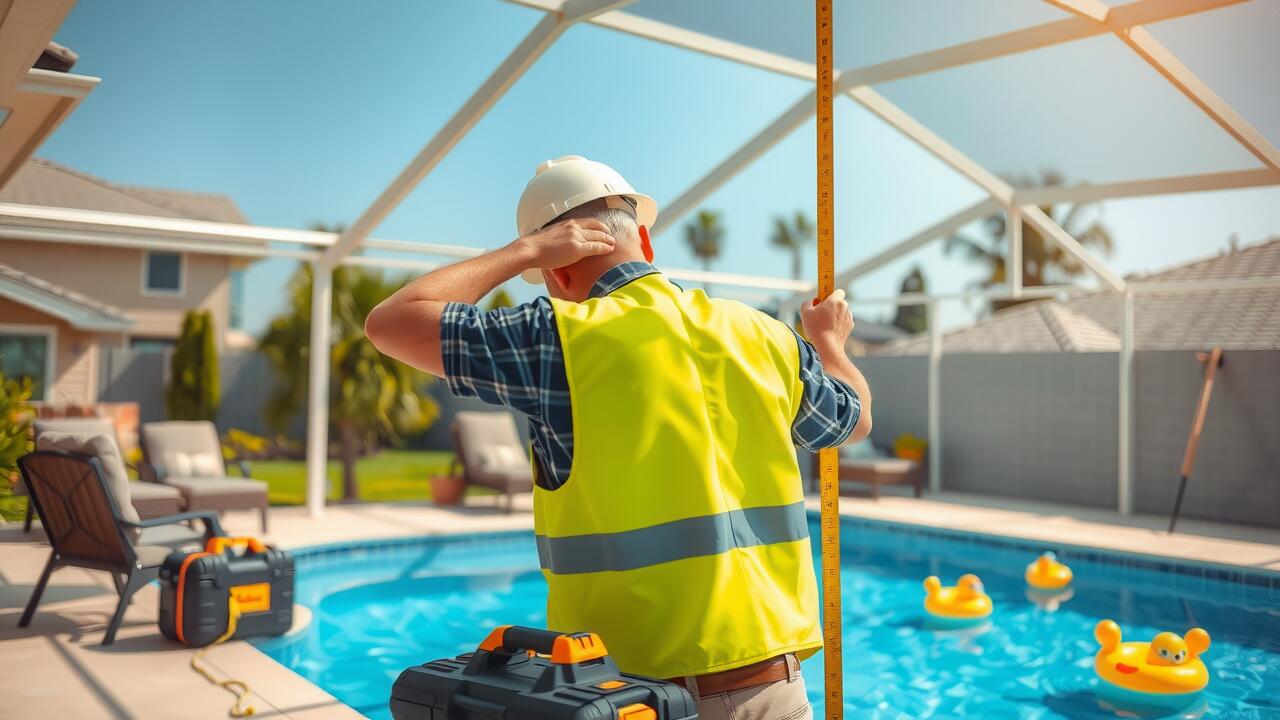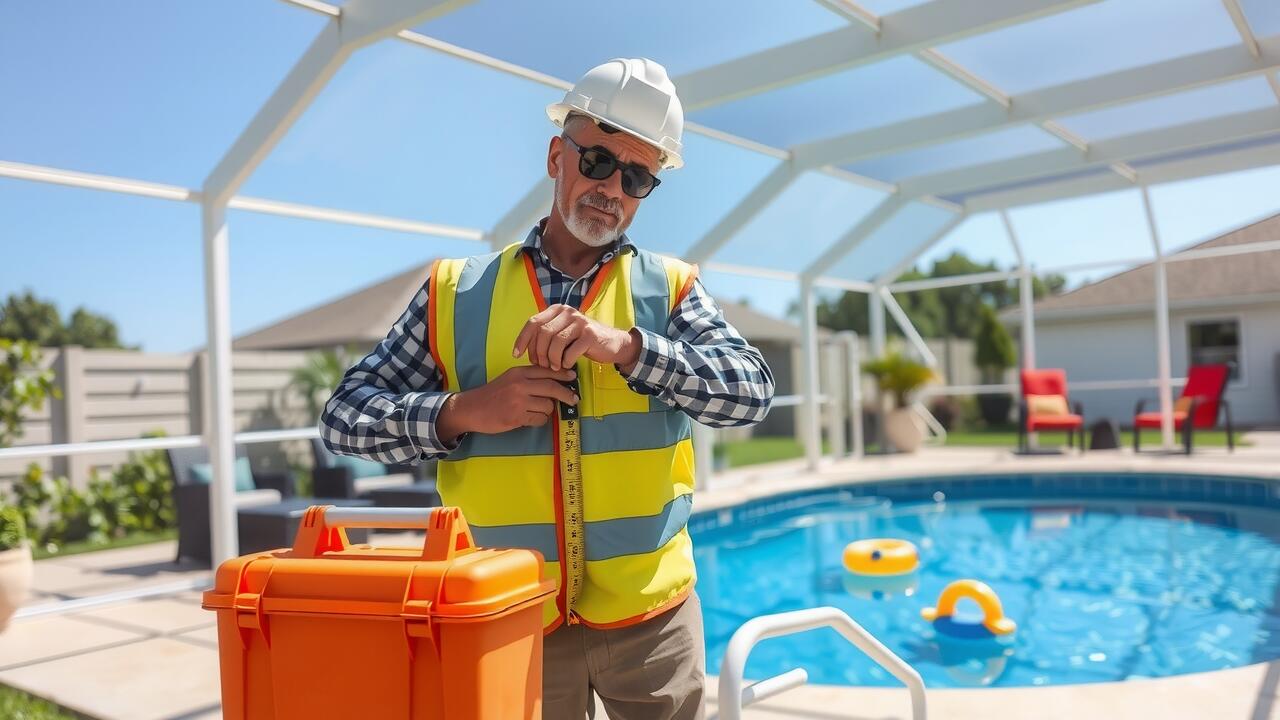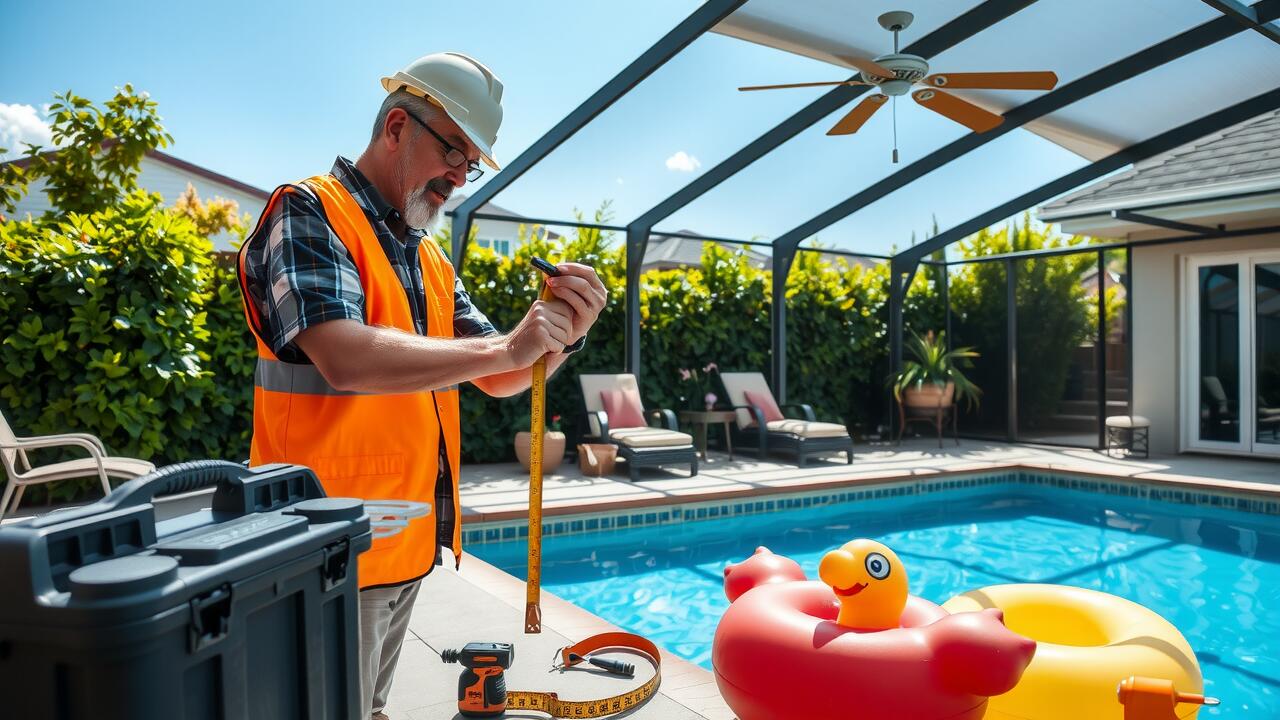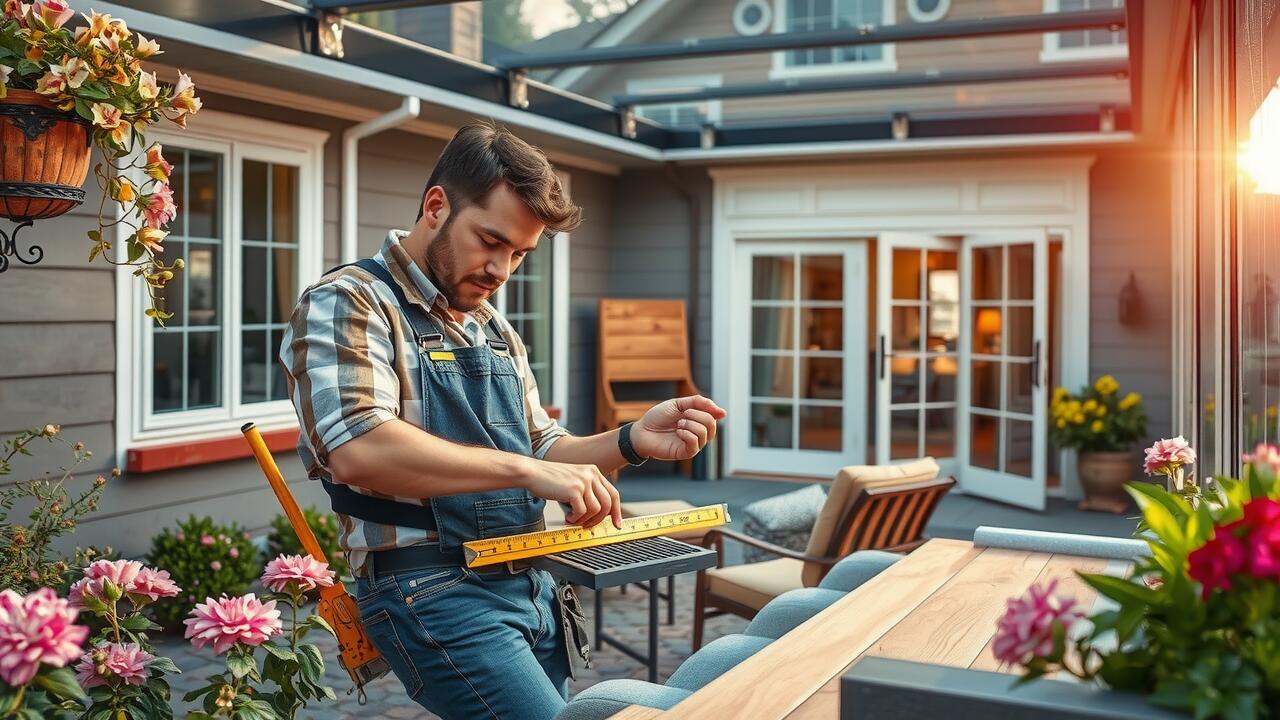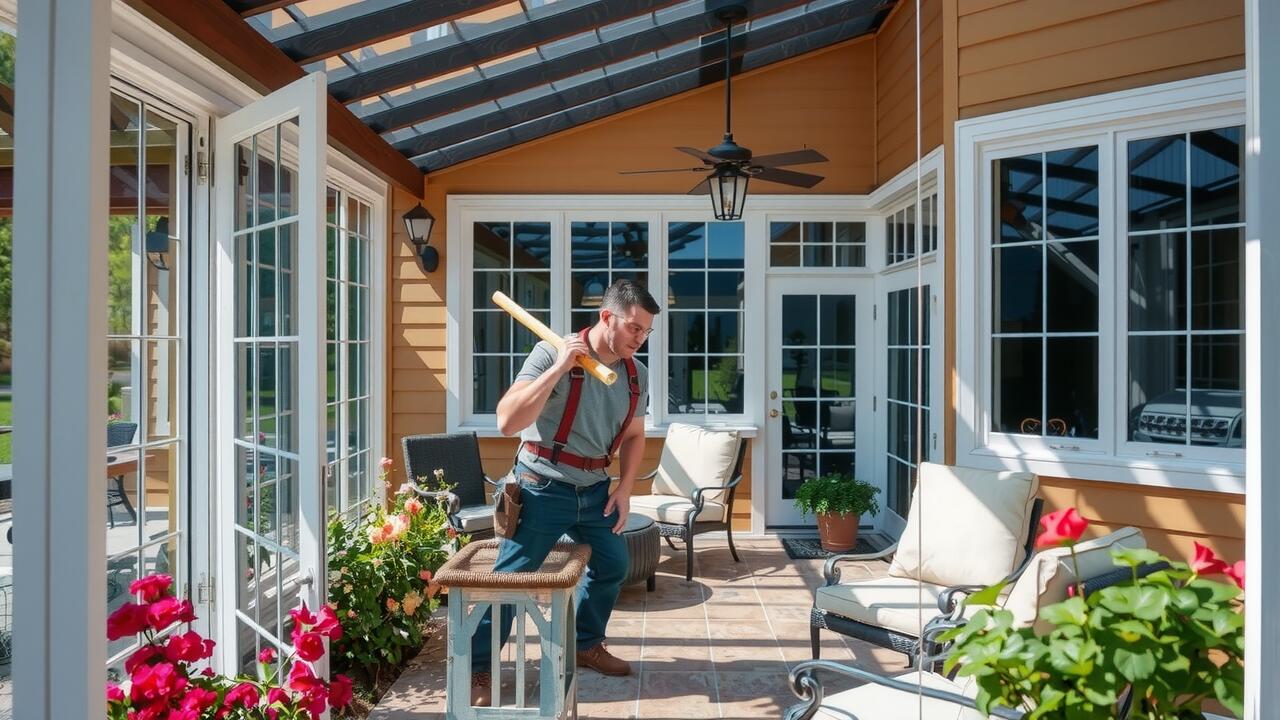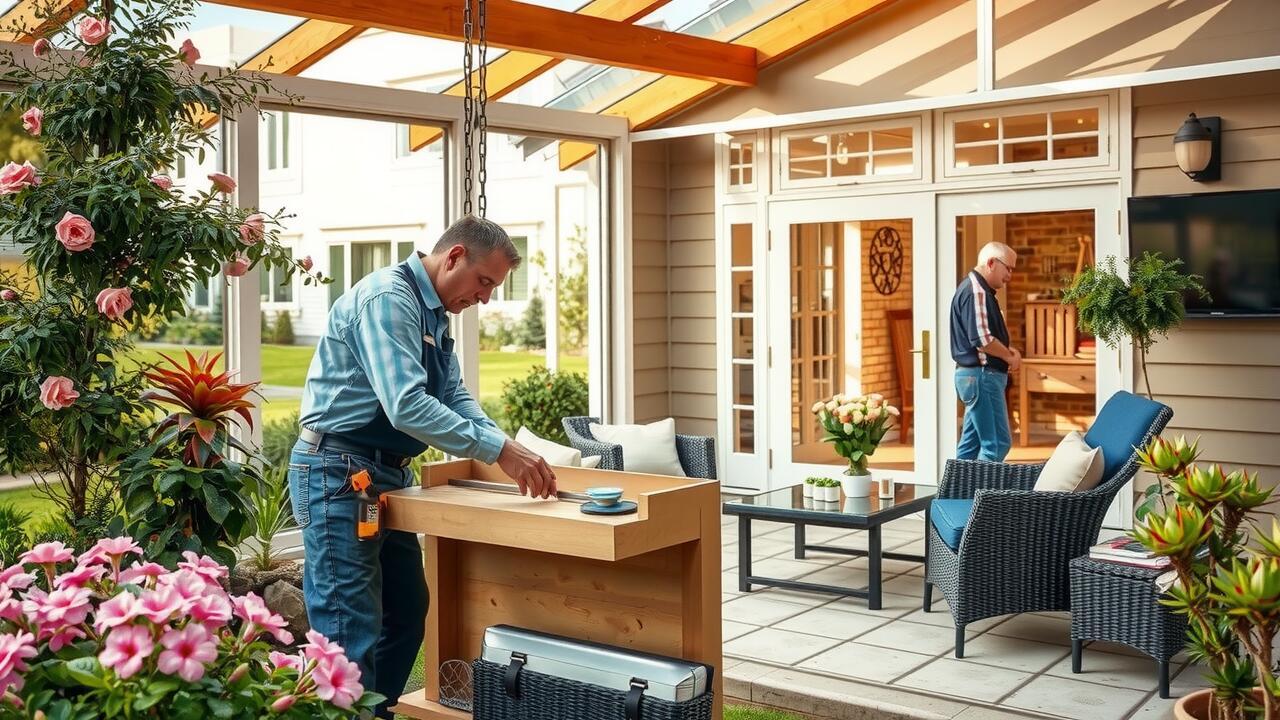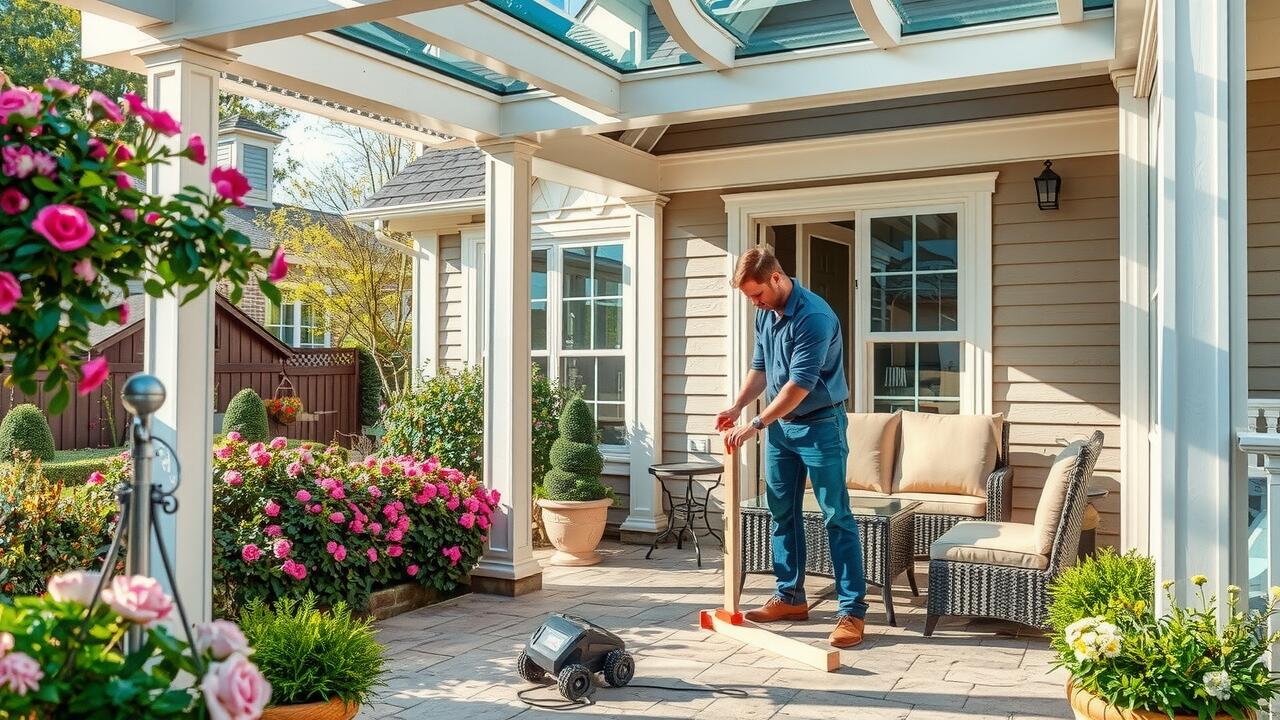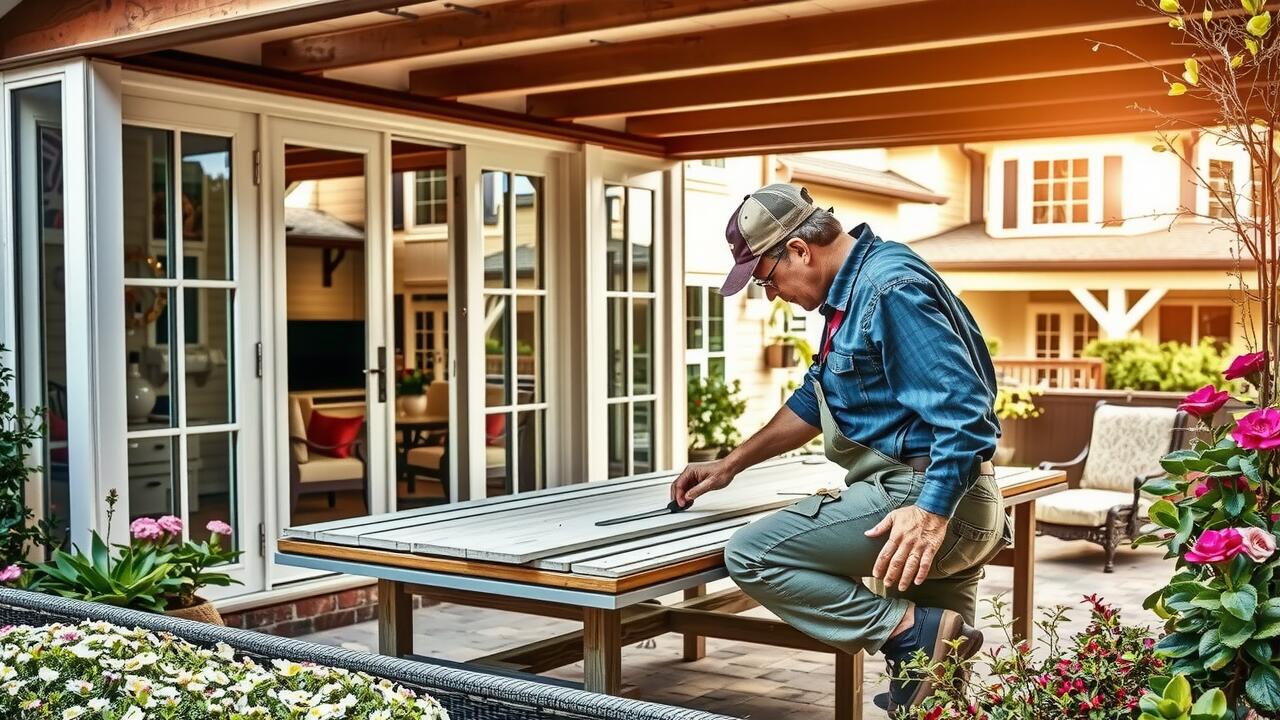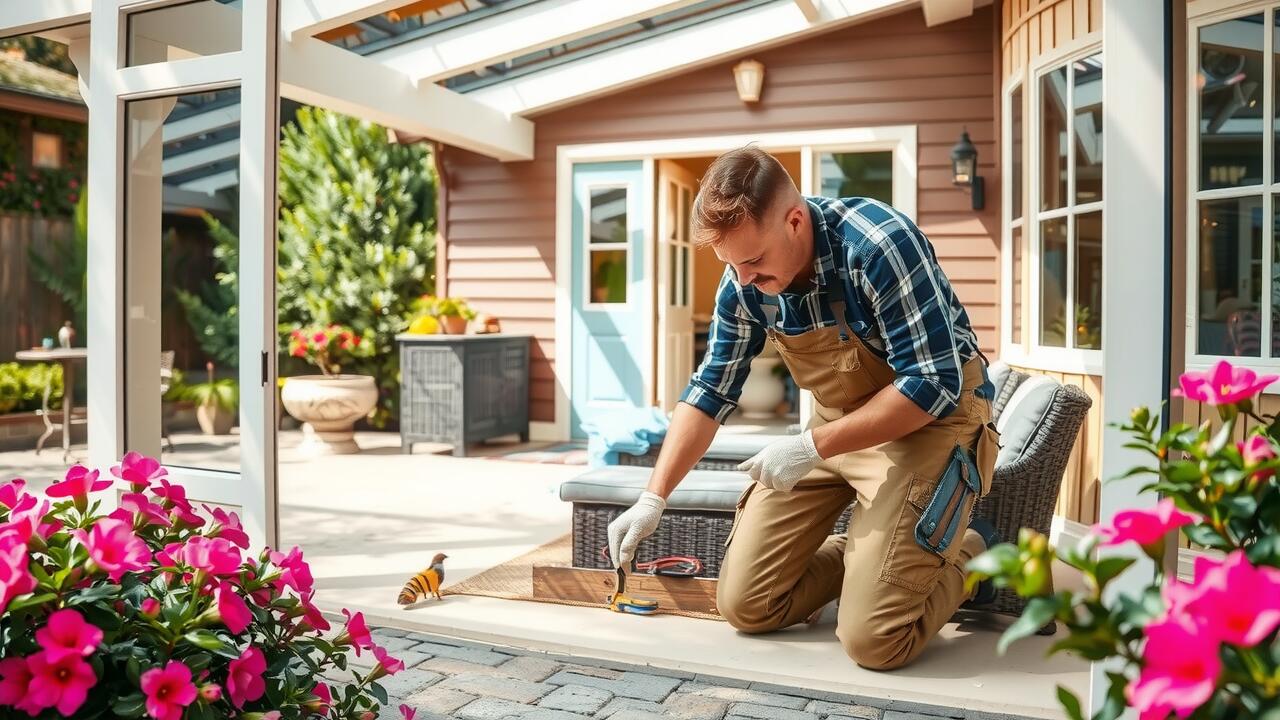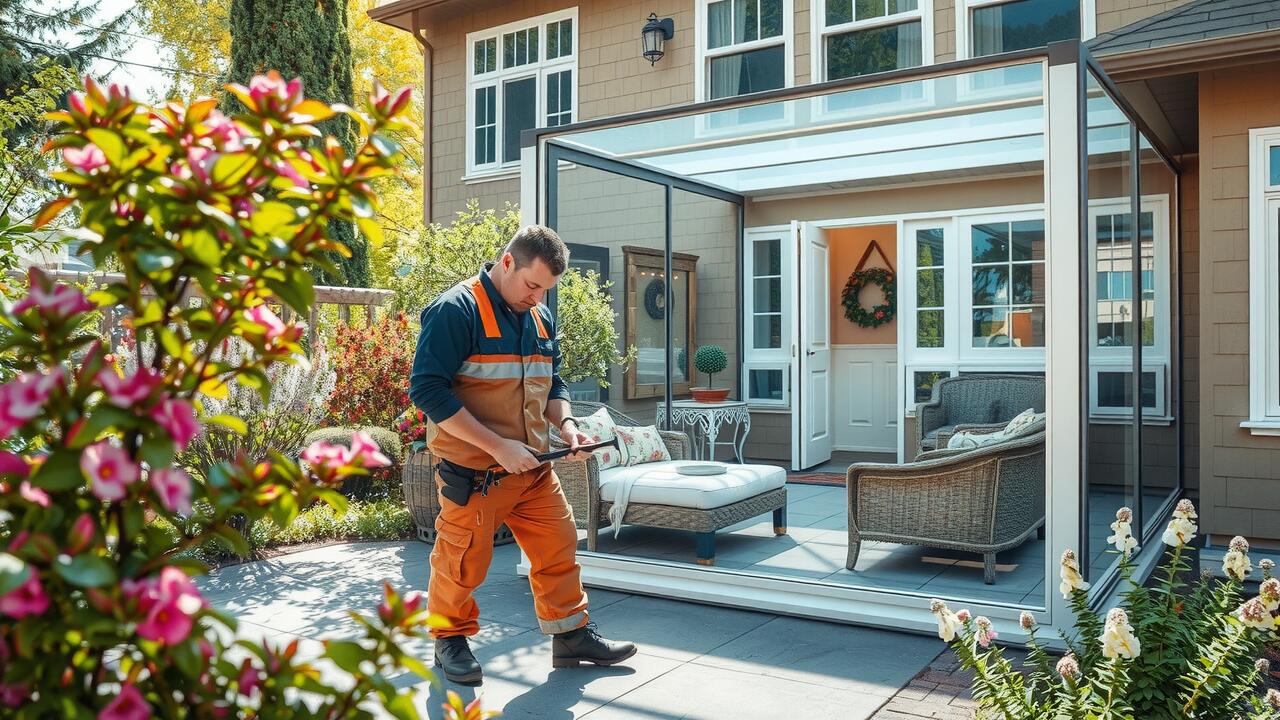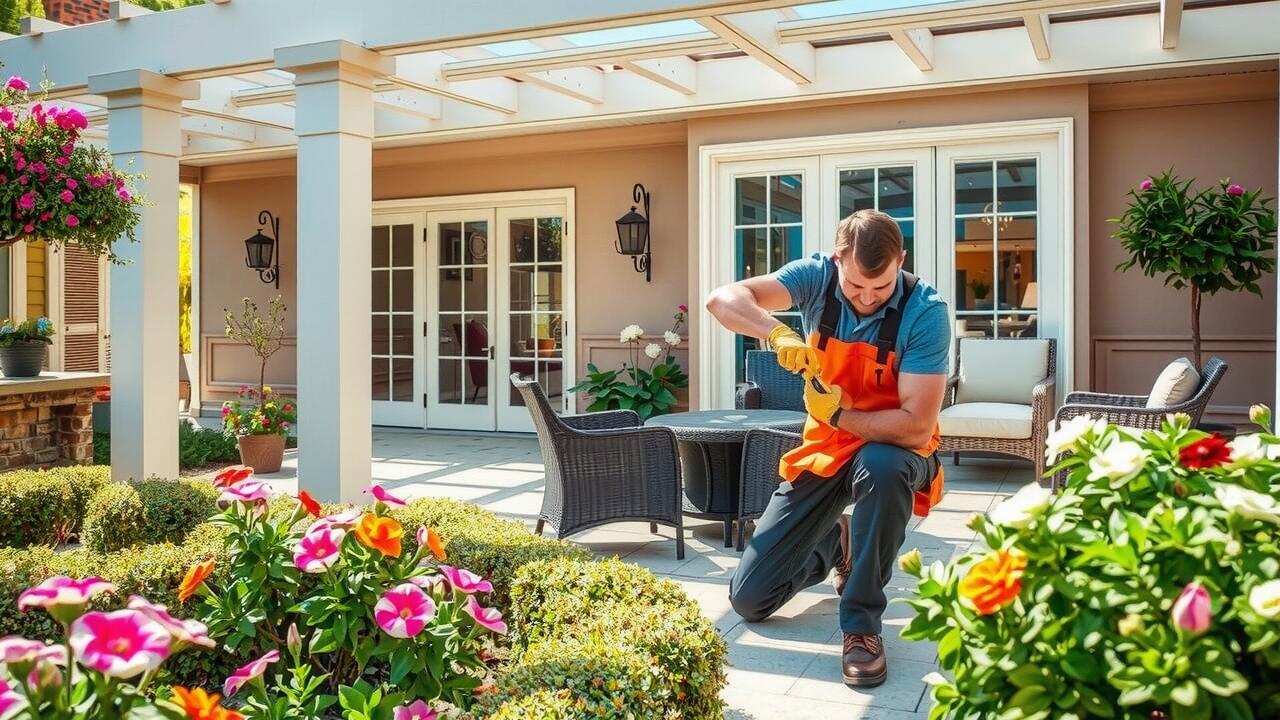Category: Uncategorized
Aesthetic Considerations
Pool enclosures can significantly enhance the visual appeal of outdoor spaces. With a variety of designs and materials available, homeowners have the option to choose styles that seamlessly blend with their existing architecture. Whether opting for a sleek modern look or a more traditional design, these enclosures can add a polished touch that elevates the entire landscape of a property.
Incorporating pool enclosures also opens up opportunities for customization. Homeowners can select colors, shapes, and features that reflect personal tastes and preferences. This adaptability allows pool enclosures to serve as a functional addition while also acting as an aesthetically pleasing element in the backyard. With thoughtful design choices, these enclosures can transform a simple pool area into a stunning outdoor retreat.
Custom Designs to Match Your Home
Pool enclosures offer a range of custom design options that can seamlessly blend with your home’s existing architecture. Homeowners have the ability to choose from various materials, colors, and styles to create an enclosure that complements their outdoor space. Whether you prefer a sleek modern look or a more traditional aesthetic, customized enclosures can elevate the overall appearance of your property. Tailored designs also ensure that the enclosure enhances not only the pool area but the entire home environment.
Incorporating features such as decorative screens or elegant entryways adds to the visual appeal of pool enclosures. Many manufacturers offer bespoke solutions, allowing for adjustments in size and shape to accommodate any layout. These customizations provide an opportunity to create a unique outdoor oasis that reflects personal taste. By thoughtfully designing your pool enclosure, you can increase the overall value of your home while enjoying a more tailored outdoor experience.
Privacy and Comfort
Pool enclosures offer significant advantages when it comes to privacy and comfort. By creating a barrier between your swimming area and the outside world, these structures provide a secluded environment where you can enjoy leisure time without concerns about prying eyes. The added privacy allows for carefree relaxation and entertaining, enhancing the overall enjoyment of your pool area.
In addition to privacy, pool enclosures can also mitigate discomfort caused by wind and other weather elements. By sheltering the pool, these enclosures help maintain a more stable temperature in the water. This is especially beneficial during colder months when wind chill can make swimming less appealing. Investing in pool enclosures ultimately leads to a more enjoyable and comfortable swimming experience.
Shielding from Wind and Neighbors
Pool enclosures enhance the outdoor experience by creating a barrier against wind and unwanted attention from neighbors. High-quality enclosures provide a tranquil setting for relaxation and recreation. They allow pool owners to enjoy their space without worrying about the prying eyes of those nearby. By shielding the pool area from gusts of wind, these structures help maintain a comfortable environment.
In addition to creating privacy, pool enclosures also contribute to the overall usability of the pool during different seasons. Even on blustery days, individuals can still enjoy the water without disrupting their time outdoors. The protective walls can transform a chilly afternoon into an enjoyable swim, making it easier to host gatherings or simply unwind in a peaceful setting. The blend of privacy and comfort offered by pool enclosures can significantly elevate the enjoyment of outdoor living.
Compliance with Local Regulations
Homeowners must be aware of local regulations when considering pool enclosures. Many municipalities have specific codes regarding pool safety that dictate the design and installation of enclosures. These regulations often include height requirements, fencing materials, and gate locking mechanisms, ensuring that the enclosure adequately safeguards the pool area, particularly for children and pets.
Compliance with these regulations is essential for both safety and liability reasons. Not adhering to local laws can result in fines or mandatory removal of the pool enclosure. Property values can also be affected if a home does not have a compliant structure in place. By ensuring that pool enclosures meet local standards, homeowners can enjoy their pools with peace of mind while adhering to legal obligations.
Meeting Safety Standards
Pool enclosures play a significant role in enhancing safety around swimming areas. Many local regulations mandate the installation of barriers to prevent accidental access, particularly by children and pets. Pool enclosures are designed to meet these safety standards, providing peace of mind for homeowners. They act as a physical barrier, effectively reducing the risk of drowning incidents and ensuring that only those permitted can access the pool area.
In addition to fulfilling safety requirements, pool enclosures often incorporate features that enhance their protective qualities. Many modern designs include secure locking mechanisms and durable materials that withstand the elements. By adhering to industry standards, pool enclosures not only add aesthetic value but also contribute to a safer environment, promoting responsible pool ownership.
FAQS
What are the main benefits of having a pool enclosure?
Pool enclosures provide various benefits, including enhanced safety, increased privacy, reduced maintenance, and extended swimming seasons. They also contribute to aesthetics by allowing for custom designs that complement your home.
Can pool enclosures be customized to fit my home’s design?
Yes, pool enclosures can be customized in various styles, colors, and materials to match the architectural design of your home, ensuring that they blend seamlessly with your existing outdoor space.
How do pool enclosures enhance privacy?
Pool enclosures create a barrier between your pool area and the outside world, shielding you from neighbors and passersby, which allows for a more comfortable and private swimming experience.
Are there specific local regulations regarding pool enclosures?
Yes, many areas have specific building codes and regulations regarding pool enclosures. It’s essential to check with your local authorities to ensure compliance with safety standards and zoning laws.
Do pool enclosures provide any safety benefits?
Absolutely! Pool enclosures help prevent accidents by restricting access to the pool area, especially for young children and pets. They can also offer protection from environmental hazards like debris or insects.
Regional Variations in Value Impact
The impact of pool enclosures on home value varies significantly across different regions. In areas where warm weather is prevalent and pools are common, like Florida and parts of California, the addition of a pool cage can be seen as an enhancement. Buyers in these markets often prioritize outdoor living spaces, making a well-designed enclosure a valuable feature. Conversely, in regions where colder climates dominate, the importance of pool enclosures diminishes. Here, potential buyers might view them as unnecessary, which can limit their influence on property values.
Local real estate trends also play a crucial role in determining how much pool enclosures impact home value. In some neighborhoods, a pool cage may be considered a desirable amenity, aligning with community preferences for outdoor entertaining and leisure. In contrast, in areas that do not have a strong pool culture, the investment in a pool enclosure might not yield the expected return. Understanding these regional dynamics is essential for homeowners considering adding a pool cage, as they can greatly influence overall market appeal.
How Geography Influences Home Value
Geography plays a significant role in determining home value, particularly in regions where outdoor living spaces are a primary draw for buyers. In areas with warmer climates, such as Florida and Southern California, properties with outdoor amenities, including Pool Enclosures, often command higher prices. The appeal of enjoying the outdoors year-round, coupled with the ability to extend the swimming season, enhances the attractiveness of homes with these features. Buyers in these regions frequently prioritize properties that offer both aesthetics and functionality, reflecting their lifestyle choices.
Conversely, in cooler climates, the demand for Pool Enclosures may be less pronounced. Homes in these areas might focus more on indoor amenities that provide comfort during the colder months. Real estate trends indicate that while outdoor features can add value, their impact varies based on local preferences and weather conditions. Buyers in regions with shorter summers may not see the same value in Pool Enclosures as those in sunnier locales. This geographical influence ultimately shapes the desirability and valuation of properties, making it essential for homeowners to consider these factors when assessing their property’s worth.
Potential Challenges with Pool Cages
Homeowners may face several challenges when considering the installation of pool enclosures. These structures can be costly, requiring a significant upfront investment that not all buyers might be willing to make. Additionally, maintenance costs can accumulate over time. Keeping the enclosure clean and in good repair is essential, and neglecting this can lead to further expenses down the line.
Another aspect to consider is local building regulations and restrictions surrounding pool enclosures. Different regions have varying codes that govern how these structures can be constructed. Navigating this regulatory landscape can be complicated, and failing to comply with local standards may result in fines or the necessity of costly modifications. Homeowners should conduct thorough research to understand these requirements before proceeding with installation.
Considerations Before Installation
Before installing pool enclosures, homeowners should evaluate their specific needs and the environment around their property. The local climate plays a crucial role in determining the type and material of the enclosure. For instance, regions with high humidity or heavy rainfall may require screens that withstand moisture, while areas with strong winds might need sturdier frames. Understanding these factors not only helps in selecting an appropriate design but also ensures that the installation meets local regulations and permits.
Another important consideration is the aesthetic impact of pool enclosures on the overall property. While functionality is essential, homeowners should choose designs that complement their home’s architecture and landscaping. Potential buyers often appreciate a cohesive look, which can enhance property appeal. Investing time in researching various styles and materials can help in making an informed decision, ensuring that the enclosure adds value rather than detracting from the property’s charm.
Buyer Preferences and Pool Cages
Home buyers often prioritize specific features when searching for their ideal property. Pool enclosures can be a significant draw, particularly in regions with warm climates where outdoor living is valued. These structures not only provide protection from insects and debris but also enhance the usability of outdoor spaces throughout the year. Buyers looking for a property with a pool might see an enclosure as a necessary addition rather than an optional extra.
However, preferences can vary widely among potential buyers. Some individuals may prefer a more natural, unencumbered outdoor experience and might view pool enclosures as restrictive. Different demographics also exhibit varying attitudes toward these structures; families with young children may favor the safety aspect of pool enclosures, while younger buyers might prioritize aesthetics and open space. Understanding these preferences can help sellers position their properties more effectively in the market.
What Home Buyers Want in a Property
Home buyers today often seek features that enhance both aesthetics and functionality. Pool enclosures, for instance, have gained popularity due to their ability to create a seamless transition between indoor and outdoor spaces. Many buyers appreciate the added protection these structures offer, not only from debris but also from insects and harsh sun. The visual appeal of a well-integrated pool cage can make a property feel more luxurious, contributing to an overall impression of quality.
Another key factor influencing buyer preferences is safety, particularly for families with young children or pets. Pool enclosures provide a barrier that minimizes the risk of accidents, making homes more desirable for buyers with specific safety concerns. Additionally, energy efficiency can play a role in attracting prospective owners. An enclosed pool can potentially reduce heating costs and maintenance efforts, aligning with the preferences of environmentally conscious buyers.
FAQS
Does a pool cage really increase the value of my home?
A pool cage can potentially increase your home’s value, particularly in regions where outdoor living spaces are highly valued. However, the increase may vary based on local market conditions and buyer preferences.
How do regional variations affect the value of a home with a pool cage?
The impact of a pool cage on home value can differ significantly by region. In warmer climates, a pool cage might be seen as a valuable addition, while in cooler areas, it may not have the same appeal.
What are some potential challenges associated with installing a pool cage?
Potential challenges include the cost of installation, maintenance requirements, and possible zoning restrictions. It’s important to research these factors before deciding to install a pool cage.
What should I consider before installing a pool cage?
Before installation, consider your budget, the local real estate market, your personal use of the pool, and how a pool cage fits with the overall aesthetics of your property.
What do home buyers typically look for in properties with pools?
Home buyers often seek features like safety, usability, and aesthetic appeal in properties with pools. A well-designed pool cage can enhance safety and comfort, making the property more attractive to buyers.
Repurposing Old Materials
Repurposing old materials presents an excellent opportunity to create an affordable patio covering. Many homeowners find that salvaged items can add both charm and functionality to their outdoor spaces. For example, old doors, windows, or even shutters can be used to construct unique barriers or enclosures. By creatively arranging these materials, individuals can design patio enclosures that not only offer shade but also enhance the aesthetic appeal of their patio.
Another option is to utilize scrap wood and pallets, which are often available for free or at low cost. These materials can be transformed into slatted roofs or decorative screens that provide an innovative cover. Painting or staining the wood can help prolong its life and allow homeowners to customize the look to match their style. Incorporating repurposed materials into patio enclosures encourages sustainability while making the outdoor area comfortable and inviting.
Creative Uses for Scrap Wood and Pallets
Scrap wood and pallets can be a goldmine for innovative DIY projects, especially when looking to create budget-friendly patio enclosures. By disassembling old pallets, you can use the wood to construct screens, trellises, or even vertical garden planters. These structures not only add aesthetics to your outdoor space but also provide some privacy and protection from the elements. Incorporating a few painted or stained pieces can transform salvaged materials into a charming focal point in your patio design.
In addition to simple enclosures, you can craft furniture pieces out of scrap wood that serve dual purposes. For instance, building a bench or a table that features built-in storage can maximize your space effectively. Using pallets, you can create raised garden beds or casual seating arrangements that enhance the functionality of your patio. Such projects emphasize recycling while allowing personalization based on your style preferences. Each piece contributes to an inviting atmosphere, ideal for enjoying quiet evenings or entertaining guests.
Canvas Covers for Patios
Canvas covers offer a practical and affordable solution for shading your patio. Available in various styles and sizes, these covers can protect against sun exposure and light rain. They are lightweight and easy to install, making them a popular choice for homeowners looking to create a comfortable outdoor space. When considering canvas options, think about colors and patterns that complement your patio’s aesthetics. Durable materials will ensure your cover withstands the elements while providing the necessary shelter.
Choosing the right canvas for your patio involves assessing climate conditions and personal preferences. Some canvases come with UV protection, essential for safeguarding against sun damage. Additionally, options such as drawstring attachments or grommets can enhance the ease of setup and removal. For a more permanent solution, you might explore integrating canvas covers into patio enclosures, which can enhance both functionality and visual appeal. Proper maintenance will prolong the life of your canvas and keep your outdoor space looking fresh and inviting.
How to Choose the Right Canvas
Selecting the right canvas for your patio cover is essential for both aesthetic appeal and durability. Consider factors such as weather resistance and UV protection to ensure the longevity of your covering. Fabrics specifically designed for outdoor use often provide a higher level of durability and can withstand moisture and sun exposure without fading or degrading. Evaluate the weight of the canvas as well; lighter materials are easier to handle and install, while heavier fabrics can offer better protection.
In addition to functionality, think about the visual impact of the canvas material. Different colors and patterns can enhance the overall atmosphere of your outdoor space, reflecting personal style. If you’re looking for uniformity, some manufacturers offer coordinating patio enclosures that can match or complement your chosen canvas. This added cohesion can elevate your outdoor area while still fulfilling its practical purpose.
Greenery as Natural Cover
Utilizing greenery as a natural cover can be an excellent way to enhance the aesthetic appeal of your patio while providing shade. Planting trees and tall shrubs around the patio creates a beautiful, inviting atmosphere. A well-placed vine can also climb up trellises or pergolas, offering protection from the sun’s rays while adding a unique element to the outdoor space. Incorporating plants not only helps in regulating temperature but also adds a sense of tranquility.
When selecting the right plants for patio shade, consider varieties that thrive in your climate and soil conditions. Deciduous trees provide optimal shade during the hot summer months and allow sunlight to filter through during the winter. Additionally, designing patio enclosures with climbing plants or hanging pots can further enhance the natural cover, ensuring your outdoor area remains a comfortable retreat year-round. Creating a balance between open space and greenery allows for an enjoyable experience while maximizing the use of your patio.
Best Plants for Patio Shade
Selecting the right plants for patio shade is essential in creating a comfortable outdoor space. Consider using taller plants like sunflowers or ornamental grasses, which can provide excellent vertical coverage. These plants not only enhance the aesthetic appeal of the patio but also create a barrier against direct sunlight. Shrubs like hydrangeas or rhododendrons also make great choices for providing shade while adding lush greenery to the environment.
Incorporating plants with broad leaves can further enhance the effectiveness of natural shade. Hostas and ferns thrive in partial to full shade, making them ideal candidates for patio enclosures. Such plants not only help reduce temperatures but also contribute to a more inviting atmosphere. Placing these plants strategically around the patio can create natural cool spots, improving comfort throughout the day.
FAQS
What are some budget-friendly materials to cover a patio?
Some budget-friendly materials include repurposed wood, scrap pallets, canvas covers, and natural greenery like climbing plants or shade trees.
How can I repurpose old materials for my patio cover?
You can use scrap wood or pallets to create a unique and rustic patio cover. Simply dismantle the pallets and arrange the wood to form a structure that provides shade.
What type of canvas works best for patio covers?
When choosing a canvas for patio covers, look for durable, weather-resistant materials like polyester or treated cotton that can withstand outdoor conditions.
Which plants are best for providing shade on a patio?
Climbing plants such as wisteria, ivy, or grapevines are excellent for creating natural cover. Trees like maples or oaks can also provide shade if planted nearby.
How can I install a canvas cover over my patio?
To install a canvas cover, you can use a simple frame made of wood or metal and secure the canvas to it with grommets and ties. Alternatively, consider a retractable awning for flexibility.
Permitting and Zoning Fees
When planning to install a 20×20 patio cover, it is essential to consider permitting and zoning fees. Different cities and counties have unique regulations governing outdoor structures. Homeowners often must obtain a permit before construction can begin. These permits may involve application fees that can vary widely depending on local government policies. It’s advisable to consult your local zoning office for specific requirements regarding both patio covers and patio enclosures.
In addition to the initial permit costs, homeowners should factor in any fees associated with zoning regulations. Zoning restrictions can dictate where a structure can be placed on a property, the height and design of the cover, and the materials used. Understanding these regulations helps avoid potential fines and delays during construction. Ensuring compliance with local laws ultimately saves both time and money in the long run.
Understanding Local Regulations
Local regulations can significantly affect the cost and feasibility of constructing a 20×20 patio cover. Many municipalities have specific zoning laws that dictate where such structures can be placed on a property. Homeowners should familiarize themselves with these rules to avoid potential fines or mandatory adjustments after construction. Factors such as property lines, easements, and neighborhood codes all play a role in determining whether a patio cover adheres to local regulations.
In addition to zoning laws, obtaining the necessary permits is essential for any permanent outdoor installation, including patio enclosures. These permits often require plans and specifications to ensure compliance with safety standards. Consulting with local building authorities can clarify specific requirements. Being informed about these regulations not only helps in planning the project but can also influence the overall budget and timeline for construction.
Seasonal Discounts and Offers
Many homeowners seek out seasonal discounts and offers when planning the installation of a patio cover. Retailers often roll out promotions during spring and fall, aligning with the peak times for outdoor renovations. These limited-time deals can provide significant savings, making it a strategic opportunity for those considering enhancements like Patio Enclosures. Additionally, some local contractors may have end-of-season sales to clear inventory, often resulting in lower costs for custom projects.
The timing of your purchase can have a substantial impact on overall expenses. During the winter months, demand for patio covers tends to decrease, prompting suppliers to offer attractive discounts. Similarly, retailers may feature special promotions around holidays, enticing customers with limited-time offers on Patio Enclosures. Being vigilant about these seasonal opportunities can lead to reduced costs and allow homeowners to invest in high-quality materials or additional features without straining their budget.
Best Times to Purchase Patio Covers
Timing can significantly impact the overall cost of patio covers. Many homeowners find that purchasing during the off-season leads to more substantial savings. Retailers and contractors often offer discounts during fall and winter months as demand tends to be lower. Exploring seasonal sales or holiday promotions can also provide opportunities for better pricing.
Patio enclosures can also be more affordable when installed alongside other landscaping or home improvement projects. Combining purchases often leads to reduced labor costs or bundled discounts from contractors. Keeping an eye on local events, home expos, or trade shows can reveal special pricing or promotional offers directly from manufacturers.
Maintenance Costs Over Time
When considering the long-term financial implications of a 20×20 patio cover, it’s essential to assess the maintenance costs involved. Regular upkeep is necessary to ensure the structure remains in optimal condition. This may include cleaning, repairs, and potential replacement of components over time. Different materials can significantly influence these expenses. For example, wood may require more frequent treatment and inspections compared to metal or vinyl options.
Additionally, incorporating patio enclosures can add to the overall maintenance considerations. Enclosures often include features that may necessitate routine checks for wear and tear. Keeping screens, doors, and hardware functioning properly will require an investment of time and money. Homeowners should factor these ongoing costs into their budgeting to avoid unexpected financial burdens as the years pass.
Long-Term Financial Considerations
When considering a patio cover, it is essential to think about long-term financial implications. Beyond the initial investment, consider how the installation could affect your property value. Patio enclosures can enhance aesthetic appeal and functionality, making a home more attractive to potential buyers. Choosing quality materials and professional installation may result in lower maintenance costs and more durability over time, leading to a worthwhile investment.
Additionally, ongoing expenses play a crucial role in the long-term costs associated with patio covers. Proper maintenance is necessary to extend the lifespan of your structure and keep it looking new. Factors such as weather resistance, cleaning requirements, and occasional repairs can influence your budget. Being aware of these factors can help homeowners make informed decisions and better prepare financially for the upkeep of their patio enclosures.
FAQS
What factors influence the cost of a 20×20 patio cover?
The cost of a 20×20 patio cover can be influenced by materials used, design complexity, location, permitting and zoning fees, and any additional features like lighting or fans.
Are there seasonal discounts available for patio covers?
Yes, many retailers and contractors offer seasonal discounts, especially during the off-peak months. It’s a good idea to shop around and look for promotions during these times.
Do I need a permit to install a patio cover?
It depends on local regulations. Some areas require permits for patio covers, especially if they are attached to the house. It’s important to check with your local zoning department before starting any project.
How much should I budget for maintenance of my patio cover?
Maintenance costs can vary, but you should budget for periodic cleaning, painting or staining, and any necessary repairs. On average, maintenance can cost between $100 to $300 annually depending on the material.
When is the best time to purchase a patio cover?
The best time to purchase a patio cover is typically during the fall or winter months when demand is lower, and discounts are more common. Additionally, early spring can also offer good deals as homeowners prepare for the warmer months.
Return on Investment (ROI)
The addition of patio enclosures can significantly impact a home’s return on investment, making it an appealing option for homeowners looking to enhance their property value. By providing added living space, these enclosures offer versatility that can attract potential buyers. Whether used as a sunroom, office, or entertainment area, the functionality of an enclosed patio often leads to a favorable appraisal when selling the home.
Factors influencing ROI include the quality of materials and construction, as well as the overall design. Real estate professionals note that well-designed patio enclosures can lead to a faster sale and a higher selling price, particularly in markets where outdoor living is highly valued. Homeowners who invest thoughtfully in their patio enclosures often find that the upgrade enhances their daily life while presenting a substantial financial return when it comes time to sell.
Estimating the Value Increase
Homeowners often seek to determine the potential value increase from their investment in patio enclosures. Several factors play a crucial role in this estimation, including the quality of materials used and the overall design. A well-constructed enclosure can enhance the aesthetic appeal of a home while providing additional usable space. Real estate experts typically recommend that homeowners consider comparable properties in their area to get a clearer picture of how such improvements might influence market value.
In addition to local market trends, the usage potential of patio enclosures contributes significantly to perceived value. Enclosed patios can serve multiple purposes, from casual living spaces to home offices or play areas for children. As buyers increasingly look for functional and versatile spaces, the appeal of an enclosed outdoor area has grown. This flexibility often translates to a higher selling price when the time comes to list the property, making the investment in patio enclosures an attractive consideration for many homeowners.
Regional Differences in Value
Home values can vary significantly based on location, and this holds true for patio enclosures as well. In areas with mild climates, homeowners may find that enclosing a patio increases usable living space. This added functionality can enhance overall property appeal and may lead to a higher resale value. Conversely, regions with harsher weather patterns might see less of a return, especially if the enclosure is viewed as an unnecessary luxury rather than a practical addition.
Market trends also play a crucial role in determining the value increase associated with patio enclosures. In neighborhoods where outdoor entertainment is highly valued, these additions can be seen as attractive features, making properties more competitive. However, in regions where homes typically do not showcase such enhancements, the value added may be minimal. Understanding local preferences is essential for homeowners considering an investment in patio enclosures.
Understanding Local Real Estate Markets
Local real estate markets exhibit considerable variation in trends and buyer preferences. Homeowners must consider how regional characteristics influence the impact of patio enclosures on property value. In some areas, an enclosed patio may be seen as a desirable feature, providing additional living space that enhances functionality and aesthetic appeal. In contrast, other markets may prioritize outdoor spaces and perceive enclosures as less attractive, potentially limiting their influence on overall property value.
Understanding neighborhood dynamics is crucial for determining the appeal of patio enclosures. Factors such as climate, typical home styles, and the demographic profile of prospective buyers can significantly affect the desirability of an enclosed patio. For instance, in regions with harsher winters, homeowners may appreciate the added shelter and comfort of a patio enclosure. Conversely, in warmer climates, the emphasis might remain on open-air spaces. Savvy homeowners will benefit from researching local buyer preferences to gauge how patio enclosures might align with market demands.
Homeowner Experiences
Many homeowners have shared their experiences with patio enclosures, highlighting the benefits and challenges they faced during the process. Some appreciate the additional living space that an enclosed patio provides. It becomes a versatile area for relaxation, entertainment, or even home offices. Others mention the improvement in their yard’s aesthetics, which adds to the overall curb appeal of their property.
Feedback from homeowners also reveals varying degrees of satisfaction with the return on investment. While some see a significant increase in their home’s marketability, others find that the value added does not fully recoup the initial costs. The performance of patio enclosures in terms of value seems to depend on local market conditions and buyer preferences, impacting how homeowners evaluate their enhancements.
Testimonials from Enclosed Patio Owners
Many homeowners have shared positive experiences after adding patio enclosures to their properties. One owner in Texas noted that the added space transformed their outdoor area into a comfortable extension of their home, perfect for family gatherings year-round. They appreciated how the enclosure not only provided protection from the elements but also enhanced their home’s aesthetic appeal.
Another homeowner from Ohio highlighted that their patio enclosure served as a multi-functional space. They use it for entertaining guests and as a cozy spot for relaxing on quiet evenings. This owner emphasized that the investment in their patio enclosure significantly increased their enjoyment of their home, making it a worthwhile addition.
FAQS
Does enclosing a patio typically increase the value of a home?
Yes, enclosing a patio can often increase the value of a home by providing additional living space and improving aesthetic appeal, which may attract potential buyers.
How can I estimate the value increase from enclosing my patio?
To estimate the value increase, consider consulting with a local real estate agent or appraiser who can provide insights based on comparable sales and regional market trends.
Are there regional differences in the value added by enclosing a patio?
Yes, the value added by enclosing a patio can vary significantly by region due to differences in local real estate markets, climate, and buyer preferences.
What factors should I consider when enclosing a patio to maximize its value?
Key factors include the quality of construction, design aesthetics, integration with the existing home, and compliance with local zoning regulations.
What have other homeowners experienced after enclosing their patios?
Many homeowners report positive experiences, noting that enclosed patios provide additional usable space and enhance their enjoyment of the home, which can lead to an increase in home value.
DIY vs. Professional Installation
Many homeowners consider a DIY approach for patio enclosures to save on costs and enjoy the personal satisfaction of tackling a project. This option allows for greater flexibility in design choices and materials. For those with experience in construction or home improvement, the process can be manageable. Various online resources, including videos and articles, provide guidance on techniques and best practices.
However, professional installation offers expertise and efficiency that might not be replicated in a DIY project. Licensed contractors bring experience and knowledge of local building codes, ensuring the patio enclosure meets safety standards. They can also complete the installation quickly, minimizing disruption to outdoor spaces. Investing in professional help can provide peace of mind, particularly for complex designs or larger structures.
Pros and Cons of Each Approach
Choosing between a DIY approach and hiring a professional for patio enclosures involves weighing various benefits and drawbacks. DIY projects can save money and allow for greater personal customization. Homeowners may enjoy the process and acquire new skills. However, this approach may lead to mistakes if the individual lacks construction experience. Additionally, the time commitment can be significant, potentially extending the project far longer than anticipated.
On the other hand, professional installation offers expertise and a smoother process. Contractors have experience, ensuring the enclosure meets local code requirements and is built to last. This option might come with higher costs, which can be a deterrent for budget-conscious homeowners. Relying on professionals also means less personal involvement in the designing phase. It can limit the creative aspect for those who prefer a hands-on experience.
Maintenance Tips for Enclosed Patios
Regular maintenance is essential for keeping your patio enclosures in good condition. Start by inspecting the structure for any signs of wear or damage, especially around joints and seals. Replace any worn weather stripping to prevent drafts and moisture intrusion. Clean the windows and screens frequently to maintain visibility and airflow. Stains on flooring or walls can detract from the overall appeal, so it’s important to address spills and dirt promptly using appropriate cleaning products.
Additionally, ensure proper drainage around the patio enclosures to avoid water pooling, which can lead to more serious issues over time. Keep an eye on the vegetation surrounding your enclosed space; overgrown plants can cause damage to gutters and walls. Regularly check the heating and cooling systems to ensure they are functioning efficiently, making seasonal adjustments as necessary. Taking these steps will enhance your enjoyment of the space while preserving its value.
Keeping Your Space Clean and Functional
Maintaining an enclosed patio requires regular attention to ensure the space remains clean and functional. Regular sweeping and vacuuming help remove dust and debris that can accumulate over time. Additionally, using suitable outdoor furniture covers when the space is not in use can protect against moisture and UV damage. Consider incorporating storage solutions for cushions and smaller items, making it easier to keep the area organized and tidy.
Patio enclosures often attract moisture, which can lead to mold and mildew if not addressed promptly. Employing a dehumidifier can significantly improve air quality and reduce excess humidity levels. Routine window and door checks are important too; ensuring that seals are intact will prevent drafts and water entry. By incorporating these maintenance practices, homeowners can enjoy their enclosed patios without the worry of deterioration or clutter.
Enhancing Comfort in an Enclosed Patio
Creating a comfortable atmosphere in an enclosed patio involves carefully considering both heating and cooling solutions. With patio enclosures, you can effectively manage temperature fluctuations throughout the year. Insulated windows and doors contribute significantly to maintaining a comfortable environment, whether during the sweltering summer months or the chilly winter evenings. Adding ceiling fans can help circulate air, while space heaters or electric fireplaces can provide warmth, ensuring your patio remains a welcoming spot regardless of the season.
Another aspect of comfort in an enclosed patio is the integration of soft furnishings and decorative elements. Comfortable seating, such as outdoor couches or lounge chairs, invites relaxation. Incorporating cushions and throws can enhance the coziness factor. To add to the inviting ambiance, consider incorporating plants or greenery within the space. Not only do they provide a touch of nature, but they also improve air quality, making your patio enclosure a delightful retreat for spending time with friends and family.
Heating and Cooling Solutions
Heating and cooling solutions play a crucial role in maintaining a comfortable environment within patio enclosures. One popular option for heating is the installation of electric or gas heaters. These units provide warmth during colder months without requiring extensive modifications to the structure. Electric heaters are often easy to install and can be adjusted to different settings, making them a convenient choice for many homeowners.
For cooling, ceiling fans and portable air conditioning units are effective methods to circulate air and maintain a pleasant temperature. Ceiling fans add a decorative element and can be integrated with the existing design of patio enclosures. Portable air conditioners offer flexibility, allowing you to control the temperature easily while being able to move the unit as needed. Both solutions enhance the usability of the patio year-round, ensuring the space remains inviting regardless of the weather.
FAQS
Can I enclose my existing patio without a permit?
It depends on local building codes and regulations. Many areas require a permit for enclosing a patio, so it’s essential to check with your local authorities before starting the project.
What materials are best for enclosing a patio?
Common materials for enclosing a patio include glass, screen, vinyl, and wood. Each material has its own benefits and drawbacks, so consider factors like insulation, aesthetics, and maintenance when making your choice.
How much does it typically cost to enclose a patio?
The cost to enclose a patio can vary widely based on size, materials, and whether you’re opting for DIY or professional installation. On average, you might expect to spend anywhere from $5,000 to $15,000.
Can I add heating and cooling to my enclosed patio?
Yes, there are various heating and cooling solutions available, including electric heaters, portable fans, and HVAC systems. Consider your climate and how you plan to use the space when choosing the right solution.
What maintenance is required for an enclosed patio?
Maintenance for an enclosed patio typically includes regular cleaning of surfaces, checking for leaks or wear in seals, and ensuring that heating and cooling systems are functioning properly.
The Importance of Permits
Obtaining the necessary permits is a crucial step when planning Patio Enclosures. Local regulations often dictate the requirements for these projects, which can vary significantly based on location. Adhering to the permitting process ensures compliance with safety standards and zoning laws. Failing to secure proper permits can lead to fines or complications when selling a property.
While researching permits, homeowners should pay attention to specific regulations related to the size and structure of the enclosure. Different jurisdictions may have varying codes regarding building materials, design aesthetics, and proximity to property lines. Understanding these requirements helps avoid costly mistakes and delays in the project timeline.
Fees and Requirements
When planning for patio enclosures, it’s essential to familiarize yourself with the required permits and associated fees. Local building codes typically mandate obtaining permission before starting any enclosure project. The specific requirements can vary significantly from one municipality to another, so consulting your local zoning office or building department is crucial. This ensures that you comply with regulations, avoiding any potential fines or complications later on.
You’ll also want to factor in the costs associated with these permits, which can add up based on the complexity of your project. Fees may include application costs, inspection fees, and possibly additional charges for environmental assessments. Understanding these financial obligations upfront will help you budget more effectively for your patio enclosure and minimize unexpected expenses during construction.
Seasonal Considerations for Patio Enclosures
Seasonal changes can significantly influence the timing and cost of patio enclosures. Spring often emerges as a popular season for construction projects, as the weather becomes milder, allowing for smoother building processes. However, homeowners may encounter higher demand and potentially elevated prices during this peak season.
Fall can also present a favorable window for enclosing patios, especially in areas that enjoy extended mild weather. Lower demand for construction services during this time can lead to better pricing and more availability from contractors. Additionally, some homeowners may find that completing patio enclosures in the fall allows them to enjoy their new space throughout the winter months.
Best Time to Start Your Project
Timing can significantly influence the overall success of your patio enclosure project. Spring and early summer often serve as the most favorable seasons to start. Warmer temperatures and longer days provide ample opportunity for construction and finishing touches. Additionally, beginning your project during this time allows for easier access to materials and potential contractors who may have more availability before the peak building season.
In contrast, starting your patio enclosure in late fall or winter may pose challenges. Weather conditions can lead to delays and complications during construction. While off-season projects may sometimes yield cost savings, the risk of adverse weather must be carefully weighed. Understanding local climate patterns can help in deciding the optimal timeframe to ensure a successful and efficient build.
Budgeting Tips for Your Enclosure
Creating a budget for your patio enclosure requires a thorough understanding of the various costs involved. Start by researching materials, labor, and any additional features you might want to include, such as screens or heating systems. It’s beneficial to gather multiple quotes from contractors to find a competitive rate. Factor in the cost of permits, which can vary by location, as well as any potential design fees if you’re hiring an architect.
Setting realistic financial goals is crucial for keeping your project on track. Determine how much you can comfortably spend without compromising your overall financial health. Consider setting aside a contingency fund for unexpected expenses that may arise during construction. This approach will help you manage your budget effectively while ensuring that the final product meets your expectations. Patio enclosures can enhance your living space, and proper financial planning can make this investment rewarding.
Setting Realistic Financial Goals
Setting realistic financial goals for your patio enclosure project is crucial to ensure a smooth process and satisfaction with the final result. Start by researching the average costs associated with different types of enclosures, including materials, labor, and any additional features you may want. By understanding these factors, you can create a budget that reflects your desired outcome without leading to overspending.
Consider potential fluctuations in expenses that might arise due to unforeseen circumstances or changes in design. It can be helpful to include a buffer in your budget to accommodate any unexpected costs that may arise throughout the project. Patio enclosures can vary widely in price based on size, complexity, and materials, so having a clear financial plan will help you navigate the selection process and make informed decisions.
FAQS
What is the average cost to enclose a patio?
The average cost to enclose a patio can range from $5,000 to $20,000, depending on factors such as size, materials, and the complexity of the project.
Are permits required for enclosing a patio?
Yes, permits are often required for patio enclosures. It’s important to check with your local building department to understand the specific requirements and fees in your area.
What materials are commonly used for patio enclosures?
Common materials for patio enclosures include screen, glass, wood, and aluminum. Each material has its own cost and aesthetic considerations.
When is the best time to start a patio enclosure project?
The best time to start a patio enclosure project is typically in the spring or early fall when weather conditions are favorable for outdoor construction.
How can I budget for my patio enclosure project?
To budget for your patio enclosure project, start by setting realistic financial goals, researching material costs, and obtaining quotes from contractors to get a clearer idea of the total expenses involved.
Cost Comparison
When considering the cost of adding a 12×12 sunroom, one major factor is the choice between DIY installation and hiring professionals. DIY projects might initially seem more budget-friendly. Homeowners can save on labor costs, but they must account for the expenses related to materials and tools. This approach requires a certain skill level, and unexpected challenges can lead to additional costs. Purchasing pre-fabricated kits from companies like Patio Enclosures could simplify the process, offering comprehensive solutions for those who prefer a hands-on approach.
On the other hand, professional installation typically guarantees quality craftsmanship. Contractors bring experience and specialized tools, which can minimize complications during the build. While this option usually entails higher upfront costs, it often saves time and ensures compliance with local building codes. Homeowners may find that the investment pays off in the long run through enhanced durability and aesthetic appeal, especially when incorporating features that blend seamlessly with existing structures.
Pros and Cons of Each Approach
Opting for a DIY sunroom installation offers several advantages, including potential cost savings and the opportunity to customize the space according to personal preferences. Homeowners who take the DIY route can often utilize affordable materials and engage in labor themselves, reducing overall expenses. Moreover, this approach allows for creative input in design and layout. However, it requires a significant time investment and carries the risk of construction mistakes that could lead to additional expenses or structural issues.
On the other hand, hiring professionals for sunroom installation typically ensures a higher level of craftsmanship and adherence to local building codes. Experienced contractors can efficiently manage the project, from acquiring necessary permits to coordinating with suppliers. This convenience comes at a higher price, with installation costs often reflecting their expertise. While some homeowners might find the idea of professional installation appealing, it is essential to weigh this benefit against the financial implications, especially when considering additions like Patio Enclosures.
Long-Term Savings and Benefits of a Sunroom
A sunroom offers numerous long-term savings opportunities that can significantly enhance a home’s value and livability. By incorporating energy-efficient materials and proper insulation, homeowners can enjoy reduced energy costs throughout the year. This additional space can serve multiple purposes, from a relaxing retreat to an entertainment area, further maximizing its utility and appeal. With options like Patio Enclosures, the sunroom can seamlessly blend with the existing home structure while providing the desired functionality.
In addition to cost savings, a well-designed sunroom can increase property value. Potential buyers often appreciate the extra living space created by a sunroom, particularly one that captures natural light and offers views of the outdoors. The integration of Patio Enclosures can improve aesthetics while ensuring durability against various weather conditions. Homeowners can expect a favorable return on investment, making a sunroom not only a practical choice for personal enjoyment but also a strategic one for long-term financial gain.
Energy Efficiency and Resale Value
A sunroom can significantly enhance the energy efficiency of a home, especially when designed with the right materials. Features like insulated windows and energy-efficient glass help to maintain a comfortable temperature throughout the year, reducing reliance on heating and cooling systems. Many homeowners find that incorporating Patio Enclosures not only boosts efficiency but also allows for the enjoyment of outdoor views while minimizing energy loss.
In terms of resale value, a well-designed sunroom can serve as an attractive selling point. Potential buyers often view additional living space as an advantage, especially when it integrates seamlessly with the home’s existing structure. Homes with energy-efficient features and elegant Patio Enclosures tend to resonate well with buyers looking for comfort and style, often resulting in a higher market value.
Regional Variations in Sunroom Prices
Regional variations in sunroom prices can significantly impact the overall cost of adding this space to your home. In areas with higher labor costs, such as major metropolitan cities, homeowners might find the price of a 12×12 sunroom to be considerably elevated. Factors like building regulations and local climate conditions also play a crucial role in determining final costs. Homeowners in regions experiencing harsher weather may need to invest in more durable materials to ensure their patio enclosures are well-equipped to handle extreme conditions.
On the other hand, regions with a milder climate and lower cost of living might offer more affordable options for sunroom construction. This can make the project more appealing in terms of budgeting. In addition, some areas may have established companies specializing in patio enclosures, leading to competitive pricing and various design choices. Overall, understanding the local market can help homeowners make informed decisions about their sunroom investments.
Cost Differences Across the United States
The price of a 12×12 sunroom can vary significantly across the United States due to a range of factors, including local labor costs, material availability, and regional demand for patio enclosures. For example, states with a higher cost of living, like California and New York, tend to have higher installation prices compared to those in the Midwest and Southern regions. This disparity can add hundreds or even thousands of dollars to the total expense of constructing a sunroom.
Climate and weather patterns also play a critical role in pricing. Regions that experience extreme weather conditions often require more robust materials and insulation for patio enclosures, leading to increased costs. In contrast, areas with milder climates may allow for more economical construction options. Understanding these regional variations is essential when budgeting for a sunroom project, as it can influence the final design, materials chosen, and overall financial investment.
FAQS
What is the average cost of a 12×12 sunroom?
The average cost of a 12×12 sunroom typically ranges from $15,000 to $30,000, depending on materials, design, and whether you choose DIY or professional installation.
What factors can influence the cost of a sunroom?
Factors that can influence the cost of a sunroom include the choice of materials, the complexity of the design, labor costs in your area, and any additional features like insulation or electrical work.
Is it cheaper to build a sunroom myself or hire a professional?
Building a sunroom yourself can save on labor costs, making it cheaper overall, but it requires time, skills, and tools. Hiring a professional ensures a higher quality build but typically increases the total cost.
What are the long-term benefits of adding a sunroom to my home?
Long-term benefits of adding a sunroom include increased energy efficiency, enhanced living space, potential boost in resale value, and improved enjoyment of your home.
Are there regional differences in sunroom prices across the United States?
Yes, regional differences can affect sunroom prices due to variations in labor costs, material availability, and local regulations. Generally, urban areas may have higher costs compared to rural locations.
Maintenance Expenses Over Time
Maintenance expenses for a 10×10 patio can accumulate over time, depending on the materials used and the level of exposure to weather elements. Regular upkeep is essential to ensure the patio remains in good condition. This may involve cleaning, sealing, and repairing surfaces, which can add to the overall cost. If patio enclosures are installed, they may also require specific maintenance to prevent issues such as wear and tear from humidity or temperature fluctuations.
The type of materials chosen for a patio significantly influences long-term care costs. Natural stone or wood may need more frequent maintenance compared to composite or manufactured materials, which are generally designed to withstand the elements better. In cases where patio enclosures are equipped with screens or glass, these features might require additional servicing to ensure functionality and aesthetic appeal. By understanding these ongoing costs, homeowners can better plan their budget for maintaining a beautiful outdoor space.
Long-term Care Considerations
Carrying out regular maintenance is essential for the longevity of a patio, especially when it comes to patio enclosures. Depending on the materials used, different care requirements will be necessary. Wooden enclosures may need periodic sealing or painting to protect against weather damage, while aluminum or vinyl options can often be maintained with just cleaning. Being proactive with repairs can prevent more significant issues down the line, preserving both aesthetics and functionality.
Environmental factors will also influence maintenance needs. Areas with heavy rains or exposure to harsh sun can accelerate wear and tear. It’s advisable to inspect patio enclosures regularly for signs of wear or damage, such as rust on metal structures or cracks in any seals. Addressing these issues early can save money and hassle. Understanding the specific needs of the materials used can aid in developing a long-term care plan tailored to your patio.
Seasonal Discounts and Promotions
Finding seasonal discounts and promotions can significantly lower the cost of covering a 10×10 patio. Retailers often offer sales during specific times of the year, especially around holidays or during off-peak seasons. Home improvement stores may have clearance events to make room for new inventory. Keeping an eye on flyers and online advertisements can help homeowners spot these opportunities.
In addition to store promotions, manufacturers of patio enclosures sometimes offer rebates or discounts directly to consumers. These deals can be more prevalent during spring and fall, aligning with the outdoor renovation schedules of many homeowners. Signing up for newsletters or following brands on social media can also provide access to exclusive offers, making it easier to plan a budget-friendly project.
Best Times to Buy
Timing can significantly impact the cost of patio enclosures. Many retailers offer discounts during the off-peak seasons, typically in late fall and winter. Shoppers may find reduced prices due to decreased demand. Additionally, manufacturers often have promotional sales during holidays or special events, making it an excellent time to invest in patio enclosures.
Another strategic approach is to monitor trends in the outdoor home improvement industry. New models may be released in early spring, leading to price reductions on older inventory. Seasonal clearance events can also provide opportunities for substantial savings, especially on patio enclosures that retailers wish to move quickly before the next season. Being aware of these trends can help homeowners maximize their budget.
Cost Comparison with Alternative Options
When considering the cost of a 10×10 patio, it’s essential to compare various options available on the market. Patio enclosures offer a unique solution that provides protection from the elements while maintaining a connection to the outdoors. This feature often adds significant value to a home. However, the initial investment can be higher than traditional patios, depending on materials and design choices.
Additionally, other outdoor structures such as pergolas or gazebos may present more affordable alternatives. While these options can enhance outdoor aesthetics, they usually lack the comprehensive weather protection that patio enclosures provide. Homeowners should weigh the upfront costs against the long-term benefits, factoring in maintenance requirements and potential increases in property value.
Other Outdoor Structures
When considering options for enhancing outdoor spaces, patio enclosures provide a versatile alternative to traditional patios. These structures can create additional living space while offering protection from the elements. Enclosures often come in various styles, including screened-in options that allow for fresh air without pests, or glass enclosures which offer a panoramic view while maintaining comfort. The overall cost can vary based on the materials used and the design complexity.
In addition to patio enclosures, homeowners might explore gazebos, pergolas, and awnings to augment their outdoor infrastructure. Each of these structures brings unique benefits and aesthetic appeal. Gazebos can serve as a sheltered retreat, while pergolas provide an elegant frame for climbing plants. Awnings offer practicality, creating shade over existing outdoor seating. Assessing these options alongside patio enclosures can provide insight into what best suits the desired function and budget of the space.
FAQS
What is the average cost to cover a 10×10 patio?
The average cost to cover a 10×10 patio can range from $1,000 to $4,000, depending on the materials and design you choose.
What materials are commonly used to cover a patio?
Common materials for covering a patio include wood, composite decking, stone, concrete, and various types of outdoor fabric for shade structures.
Are there any maintenance costs associated with patio coverings?
Yes, maintenance costs can vary based on the material used. For instance, wood may require regular sealing and staining, while composite materials may need periodic cleaning, resulting in different long-term care expenses.
When is the best time to buy a patio cover?
The best times to buy a patio cover are typically during the off-season, such as fall or winter, when retailers may offer seasonal discounts and promotions.
How does the cost of a covered patio compare to other outdoor structures?
The cost of a covered patio is generally lower than that of other outdoor structures like pergolas or gazebos, but the total expenses can vary based on size, complexity, and materials used.
Pest Control Advantages
Patio enclosures serve as an effective barrier against various pests. Mosquitoes, flies, and other unwanted insects can hinder outdoor enjoyment, making it essential to create a protected space. With a well-designed patio enclosure, homeowners can enjoy the fresh air without the constant annoyance of insects. This added layer of protection enhances outdoor living experiences and allows for entertaining guests without worrying about pests.
Additionally, patio enclosures can help minimize the presence of dust and debris that often accompany outdoor living. By reducing exposure to these elements, homeowners can enjoy a cleaner environment while also safeguarding furniture and furnishings from wear and tear. The controlled environment of an enclosed patio promotes a more pleasant outdoor experience, allowing families to relax and unwind in a pest-free area.
Keeping Insects at Bay
Patio enclosures offer a significant advantage in keeping insects at bay. By creating a barrier between your living space and the outdoors, these structures effectively block unwanted pests from intruding. Mosquitoes, flies, and other nuisance insects find it difficult to penetrate the enclosed space, allowing you to enjoy your patio without the constant swatting and discomfort that outdoor spaces usually entail.
In addition to enhancing comfort, patio enclosures can also improve the overall ambiance of your outdoor area. With fewer insects around, you can spend more time relaxing, entertaining guests, or enjoying family activities. This pest control benefit makes patio enclosures an appealing choice for homeowners who want to make the most of their outdoor living spaces without the ongoing battle against insects.
Privacy and Security
Patio enclosures provide an effective barrier that enhances privacy for homeowners. They create a secluded space away from the view of neighbors and passersby, allowing individuals to enjoy their outdoor environments without feeling exposed. This added layer of confidentiality can transform an ordinary backyard into a personal oasis where people can relax, entertain guests, or engage in family activities without interruptions.
Additionally, patio enclosures contribute to overall security. Enclosed areas help deter unwanted intruders by limiting access to the home and yard. They act as an additional line of defense against potential break-ins while providing peace of mind for residents. With secure windows and doors, homeowners can enjoy their enclosed patios knowing that their property is safeguarded.
Creating a Personal Retreat
Creating a personal retreat can enhance the enjoyment of your outdoor space, and patio enclosures provide an excellent solution. These spaces offer a blend of comfort and nature, perfect for relaxation. You can furnish them with cozy seating, plants, and decorative elements, making it a sanctuary where you can unwind after a long day. The ability to control the environment adds to the appeal, allowing you to enjoy the outdoors without the unpredictability of weather or pests.
In addition to the comfort they provide, patio enclosures also serve as a buffer from the hustle and bustle of everyday life. These spaces can be tailored to fit your individual needs, whether you envision a cozy reading nook, a meditation area, or an outdoor dining space. Surrounding yourself with privacy creates a sense of tranquility that may be hard to achieve in an open patio. Patio enclosures allow you to enjoy your own slice of serenity while still feeling connected to nature.
Maintenance Requirements
Owning a patio enclosure offers distinct advantages in terms of maintenance. These structures provide protection against the elements, reducing the wear and tear from rain, snow, and UV exposure. As a result, the materials used for patio enclosures often require less frequent repairs or replacements. Regular inspections can help catch small issues before they develop into larger problems, preserving the integrity of the enclosure and its overall aesthetic.
Cleaning is another essential component of maintaining patio enclosures. Dust, debris, and pollen can accumulate on screens and surfaces, necessitating routine upkeep. A simple wash with mild soap and water can restore the appearance of the enclosure and ensure that any built-up grime does not compromise its function. By implementing a consistent maintenance schedule, homeowners can enjoy their patio enclosures with minimal hassle for many years.
Long-Term Upkeep Strategies
Long-term upkeep of patio enclosures requires regular inspections to identify any potential issues. Checking for signs of wear or damage on the structure can prevent more significant problems down the line. Maintenance tasks may include tightening screws, replacing worn-out screens, and ensuring that seals remain intact. These simple actions can help preserve the integrity and appearance of the enclosure over time.
Cleaning is another essential component of maintaining patio enclosures. Dust, dirt, and pollen can accumulate on surfaces, which not only detracts from aesthetics but may also lead to deterioration. Utilizing mild cleaning solutions and soft brushes will help keep the enclosure looking fresh while avoiding damage. Establishing a routine cleaning schedule will make it easier to enjoy the space and prolong its lifespan.
FAQS
What are the primary benefits of having an enclosed patio?
Enclosed patios offer several benefits, including improved pest control, enhanced privacy and security, and reduced maintenance requirements compared to open patios.
How do enclosed patios help with pest control?
Enclosed patios can effectively keep insects and other pests at bay, providing a more comfortable outdoor space for relaxation and entertainment without the nuisance of bugs.
Can an enclosed patio provide more privacy?
Yes, an enclosed patio creates a personal retreat by blocking the view from neighbors and passersby, allowing you to enjoy your outdoor space without feeling exposed.
What maintenance is required for an enclosed patio?
While enclosed patios may require some upkeep, they generally need less frequent maintenance than open patios, as they are shielded from the elements. Regular cleaning and occasional repairs may be necessary.
Are enclosed patios a good investment for home value?
Yes, enclosed patios can increase the overall value of your home by adding usable living space and enhancing the appeal of your property to potential buyers.
